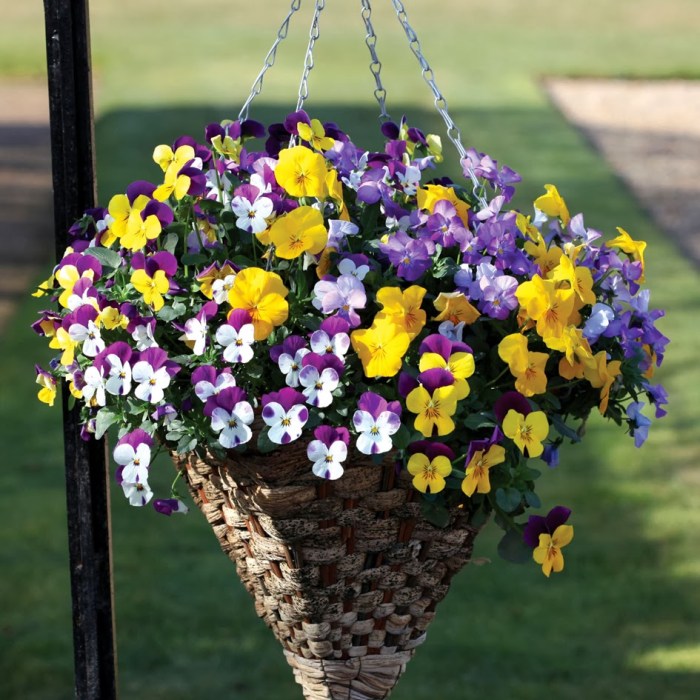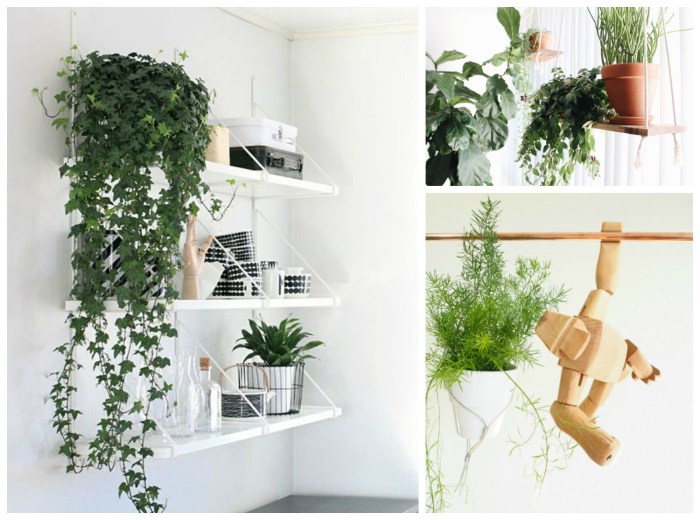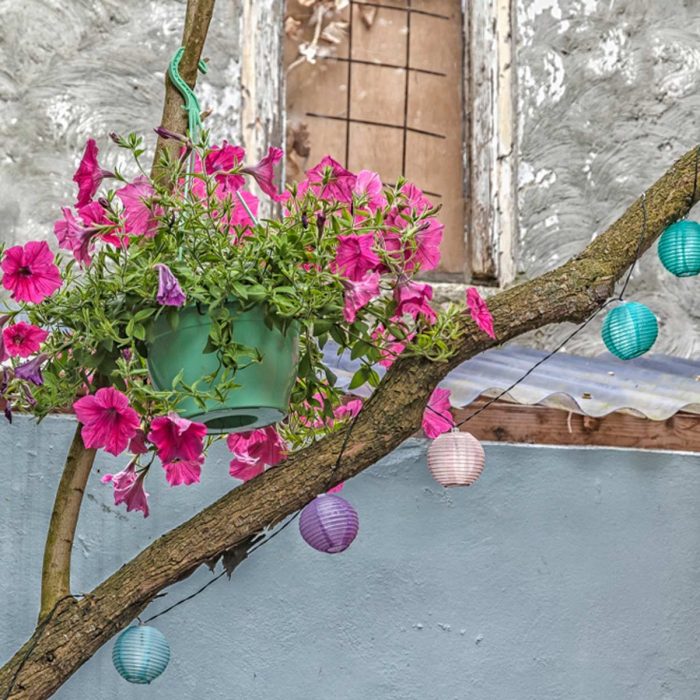10 hanging plants outdoor ideas can transform any outdoor space into a lush and inviting oasis. Whether you’re looking to add a touch of greenery to your patio, balcony, or pergola, these ideas will inspire you to create a beautiful and functional outdoor haven.
From choosing the right plants to designing stunning arrangements and creating unique DIY planters, this comprehensive guide covers everything you need to know about incorporating hanging plants into your outdoor decor.
Most Popular Hanging Plants for Outdoor Spaces
Selecting the right hanging plants for your outdoor space is essential to create a beautiful and thriving garden. Factors to consider include sun exposure, hardiness zone, and maintenance requirements. Here are the top 10 most popular hanging plants for outdoor use, along with their botanical names, key characteristics, and growing tips:
Trailing Petunias (Petunia hybrida)
- Vibrant blooms in various colors
- Prefers full sun to partial shade
- Water regularly, especially during hot weather
Fuchsia (Fuchsia spp.)
- Delicate, bell-shaped flowers
- Prefers partial shade to full shade
li>Keep soil moist but not waterlogged
Trailing Lobelia (Lobelia erinus)
- Small, star-shaped flowers
- Prefers full sun to partial shade
- Water regularly, especially during hot weather
Trailing Geraniums (Pelargonium peltatum)
- Large, showy flowers
- Prefers full sun to partial shade
- Water regularly, allowing soil to dry out slightly between waterings
Bacopa (Bacopa monnieri)
- Tiny, star-shaped flowers
- Prefers partial shade to full shade
- Keep soil consistently moist
Trailing Verbena (Verbena rigida)
- Clusters of small, fragrant flowers
- Prefers full sun to partial shade
- Water regularly, allowing soil to dry out slightly between waterings
Scaevola (Scaevola aemula)
- Fan-shaped foliage with daisy-like flowers
- Prefers full sun to partial shade
- Water regularly, allowing soil to dry out slightly between waterings
Million Bells (Calibrachoa spp.)
- Abundant, trumpet-shaped flowers
- Prefers full sun to partial shade
- Water regularly, allowing soil to dry out slightly between waterings
Mandevilla (Mandevilla spp.)
- Large, trumpet-shaped flowers
- Prefers full sun to partial shade
- Water regularly, allowing soil to dry out slightly between waterings
Ivy Geraniums (Pelargonium peltatum ‘Ivy Leaf’)
- Ivy-like foliage with trailing stems
- Prefers full sun to partial shade
- Water regularly, allowing soil to dry out slightly between waterings
Designing with Hanging Plants

Incorporating hanging plants into outdoor spaces offers a plethora of design possibilities. Whether adorning patios, balconies, or pergolas, these versatile accents can transform any area into a verdant oasis.
When selecting hanging planters, consider the size and shape of your space. Smaller planters are ideal for balconies and tight corners, while larger ones can create a dramatic focal point on patios. Opt for planters that complement your existing décor and choose materials like terracotta, metal, or wicker to add visual interest.
Creating Visually Appealing Arrangements
Arrange hanging plants in visually appealing clusters to create a sense of depth and dimension. Mix and match different plant species, textures, and colors to add interest. Consider using trailing plants to cascade over the edges of planters, creating a lush, cascading effect.
Adding Privacy
Hanging plants can provide a natural privacy screen, especially on balconies or patios overlooking busy streets. Choose fast-growing, dense plants like ivy, ferns, or trailing begonias to create a verdant barrier.
Creating Focal Points
Large, statement-making hanging plants can serve as focal points in outdoor spaces. Suspend them from the center of a pergola or over a seating area to draw attention and create a sense of grandeur.
If you’re looking for ways to add some greenery to your outdoor space, hanging plants are a great option. They can add a touch of elegance and sophistication to any patio or balcony. And with so many different types of hanging plants to choose from, you’re sure to find one that fits your style.
To hang your plants securely and stylishly, consider using 10 hanging plants hooks . These hooks are designed to hold plants of all sizes and shapes, and they come in a variety of finishes to match your décor. With the right hanging plants and hooks, you can create a beautiful and inviting outdoor space that you’ll love spending time in.
Enhancing Vertical Space
Hanging plants are an excellent way to maximize vertical space in small or narrow areas. Utilize walls, fences, or pergolas to display a variety of hanging planters, creating a lush, vertical garden that adds height and interest.
DIY Hanging Planters

Hanging planters are a great way to add a touch of greenery to your outdoor space. They can be used to create a vertical garden, or simply to add a splash of color to a patio or balcony. Best of all, they’re easy to make yourself.
There are many different ways to make a hanging planter. You can use macrame, wood, or even repurposed items. The key is to find a material that you like and that will complement your outdoor decor.
Macrame Hanging Planters
Macrame is a type of knotting that can be used to create beautiful and intricate hanging planters. There are many different macrame patterns that you can use, so you can customize your planter to match your personal style.
To make a macrame hanging planter, you will need the following materials:
- Macrame cord
- Scissors
- Measuring tape
- A hook or ring to hang your planter
Once you have your materials, you can follow these steps to make your planter:
- Cut a piece of macrame cord that is twice the length of your desired planter.
- Fold the cord in half and tie a knot at the top.
- Separate the cord into two strands and tie a knot around the hook or ring.
- Repeat steps 2 and 3 until you have created the desired length for your planter.
- Tie a knot at the bottom of the planter to secure the cords.
- Trim any excess cord.
Wood Hanging Planters
Wood hanging planters are another great option for adding a touch of greenery to your outdoor space. They are relatively easy to make, and you can customize them to any size or shape you want.
With the right hanging plants, you can create a lush and inviting outdoor space. Whether you’re looking for a pop of color or a touch of greenery, there are plenty of options to choose from. And with the help of a hanging plant holder , you can easily display your plants in style.
When selecting plants for your outdoor hanging baskets, be sure to consider the amount of sunlight and water they’ll receive. Some popular choices for outdoor hanging plants include petunias, geraniums, and impatiens.
To make a wood hanging planter, you will need the following materials:
- Wood
- Saw
- Drill
- Screws
- A hook or ring to hang your planter
Once you have your materials, you can follow these steps to make your planter:
- Cut four pieces of wood to the desired length for your planter.
- Drill holes in the corners of the wood pieces.
- Screw the wood pieces together to form a box.
- Drill a hole in the center of the bottom of the planter.
- Thread a hook or ring through the hole and secure it with a screw.
Care and Maintenance of Hanging Plants: 10 Hanging Plants Outdoor Ideas

Hanging plants add a touch of beauty and greenery to any outdoor space, but they require specific care and maintenance to thrive. Here’s a comprehensive guide to help you keep your hanging plants healthy and vibrant.
Proper watering is crucial for hanging plants. Allow the soil to dry out slightly between waterings, and avoid overwatering, which can lead to root rot. Fertilize your plants monthly during the growing season with a balanced liquid fertilizer.
Pruning
Regular pruning helps maintain the shape and health of hanging plants. Remove dead or damaged leaves and stems, and trim back overgrown plants to encourage new growth.
Pests and Diseases
Hanging plants are susceptible to various pests and diseases, including aphids, spider mites, and fungal infections. Inspect your plants regularly and treat infestations promptly with appropriate pesticides or fungicides.
Overwintering
In colder climates, hanging plants may need to be overwintered indoors. Bring them inside before the first frost and place them in a bright, cool location. Water sparingly and fertilize less frequently during the winter months.
Reviving Neglected Plants, 10 hanging plants outdoor ideas
If your hanging plants have been neglected or damaged, don’t despair. With proper care, they can be revived. Gradually increase watering and fertilizing, and prune away any dead or damaged parts. Be patient, and with time, your plants will recover their health and beauty.
Inspiring Outdoor Spaces with Hanging Plants
Hanging plants have become increasingly popular in outdoor spaces, offering a touch of greenery and tranquility to patios, balconies, and gardens. By suspending plants from above, homeowners can create vertical gardens, add a splash of color, and connect with nature in new and unexpected ways.
There are plenty of options when it comes to hanging plants for outdoor spaces, with various ideas and styles to choose from. Whether you’re looking for something classic and elegant or more modern and trendy, you’re sure to find the perfect hanging plant for your outdoor space.
For inspiration, check out 10 hanging plants john lewis . With their wide selection of hanging plants, you’re sure to find something to suit your taste and style. Once you’ve chosen your hanging plants, be sure to take care of them properly so that they can thrive and add beauty to your outdoor space for years to come.
Here are a few inspiring examples of how hanging plants can transform outdoor spaces:
A Balcony Oasis
A small balcony can be transformed into a lush oasis with the addition of hanging plants. Suspend trailing plants, such as ivy or ferns, from the ceiling to create a cascading effect. Add a few colorful blooms, such as petunias or geraniums, to brighten up the space.
The vertical greenery will create a sense of privacy and make the balcony feel more like an extension of the indoors.
A Patio Retreat
A patio can be turned into a relaxing retreat with the help of hanging plants. Suspend large baskets filled with ferns or succulents from the eaves of the house. Add a few smaller hanging planters with trailing plants, such as vinca or lobelia, to create a lush and inviting atmosphere.
The hanging plants will provide shade and privacy, making the patio a perfect place to relax and enjoy the outdoors.
A Garden Sanctuary
Hanging plants can add a touch of magic to a garden. Suspend bird feeders from tree branches to attract feathered friends. Hang baskets of flowers from pergolas or arbors to create a colorful canopy overhead. Train climbing plants, such as clematis or honeysuckle, to grow up trellises and walls, creating a living tapestry of greenery and blooms.
Benefits of Hanging Plants in Outdoor Spaces
In addition to their aesthetic appeal, hanging plants offer a number of benefits for outdoor spaces. They can:
- Enhance the ambiance and create a sense of tranquility.
- Add color and interest to vertical spaces.
- Provide shade and privacy.
- Connect with nature and bring the indoors outdoors.
- Attract wildlife, such as birds and butterflies.
Final Wrap-Up

With a little creativity and care, hanging plants can elevate your outdoor space, creating a tranquil and visually appealing environment where you can relax, entertain, and connect with nature.
FAQ Corner
What are the most popular hanging plants for outdoor use?
Some of the most popular hanging plants for outdoor use include petunias, begonias, impatiens, fuchsias, and ferns.
How do I choose the right size and shape of hanging planters?
The size and shape of your hanging planters will depend on the size and type of plants you choose. For smaller plants, you can use smaller planters, while larger plants will require larger planters. You should also consider the shape of the planter, as some shapes are better suited for certain types of plants.
How do I care for hanging plants?
Hanging plants require regular watering, fertilizing, and pruning. You should also check your plants regularly for pests and diseases.